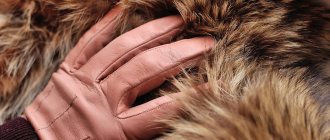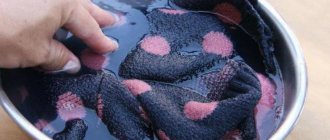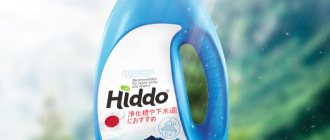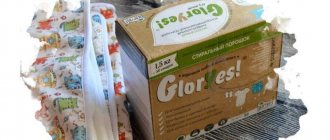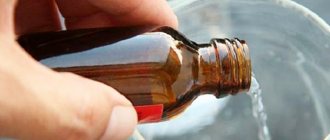Modern housewives can quickly wash them in a washing machine. Despite its simplicity, the process also has its own washing rules. To ensure that things last longer, do not wash out, do not fade, and remain in their original shape, you need to pay attention to some tips for this almost daily activity. Because the quality of washing depends not only on the washing machine.
Cotton
Brian A Jackson / Shutterstock.com
How to wash
Products made from thick cotton fabric can be washed at temperatures up to 95 °C, but it is better to experiment with hot water less often, otherwise the fibers of the fabric will quickly break down and a hole will appear on your favorite shirt.
White items can be washed at temperatures up to 65 °C; for colored items, temperatures between 30 and 40 °C are suitable (clothes may fade when washed in hot water). The optimal spin mode is up to 800 rpm. Wash colored and white items separately. Before putting your clothes in the machine, check to see if they are fading. Wet a corner or inner seam of the product with soapy water and run a dry cotton pad over it. If a distinct color mark remains on it, it is better to wash this item by hand.
Before washing, soak stained clothes in warm water with added stain remover. It is better not to soak colored items for a long time, otherwise the fabric will lose its brightness.
How to dry
After washing, shake clothes to remove wrinkles and hang them on a clothes line or drying rack. Thick cotton items can be put in the dryer: this will make your favorite terry robe soft even without conditioner.
Cotton knits should dry on a flat surface, such as a clothes dryer covered with a towel. Hanging a wet cotton sweater on a line can cause it to stretch and lose its shape.
Do not over-dry cotton clothes, otherwise you will have trouble ironing out creases in the fabric. If the item still takes too long to dry, spray it with water before ironing. Cotton can be ironed at high temperature with steam.
To make things dry faster and softer, you can get a drying machine. You simply load the laundry into the drum and take it out warm and dry. Such devices do not take up much space: the Italian brand Candy has a narrow model that easily fits into cramped closets, closets or small bathrooms. It can even be installed directly on the washing machine.
Candy dryers are equipped with a special reservoir to collect water, so they do not need to be connected to a drain. If you wash and dry things every day, you don’t have to worry about bills: the device runs on a heat pump and uses energy sparingly.
To learn more
How to sort laundry for washing
To begin with, dirty clothes need to be sorted into three categories by color : light things, colored things and dark things. It is better to wash new clothes in bright colors separately the first few times: excess dye can ruin other items.
Then separate items by fabric type. The first category will include clothes made of cotton and linen: panties, pajamas, T-shirts. Secondly, delicate items made from thin fabrics. In the third - knitted socks and sweaters. The latter includes jeans and other clothes made of coarse, dense fabric. If you don't know which category to classify an item into, check the washing instructions on the label.
In order not to waste time sorting, you can put several containers for dirty laundry and separate it at once. This is especially convenient if you have a large family and do a lot of laundry.
Down jackets
How to wash
First of all, study the information on the sew-in label: your down jacket may only be suitable for dry cleaning. If you can wash it, unfasten the hood and remove the fur. Check if there are any holes in the pockets or lining, otherwise after washing you will have to scoop out the runaway filler from the machine.
Fasten the down jacket with a zipper and buttons, turn it inside out and put it in the machine with a couple of wash balls. You can use regular tennis balls instead. They will not allow the filler to clump together.
For washing, it is better to use a special liquid detergent: regular powder is more difficult to rinse out and leaves streaks on the fabric. Wash the down jacket at a temperature not exceeding 30 °C with an additional rinse, and set the spin cycle to 600 rpm.
How to dry
After washing, unfasten the fasteners and turn the down jacket right side out. You can dry it on a hanger, but you will have to shake the jacket periodically, whipping up the filler.
If the apartment is cool, a jacket with natural down will take a long time to dry, and the filling will begin to rot. In this case, a dryer will help out: you can dry your jacket in it at a minimum temperature. Pre-wring the item by hand or in the washing machine so that water does not drip from the down jacket.
Wool
Rossella/Shutterstock.com
How to wash
Clothes made of wool are difficult to care for: if you wash your favorite sweater in too hot water, it will shrink by several sizes, and you won’t be able to restore its original appearance. For some items, washing is completely contraindicated - for example, it is better to dry-clean a cashmere jacket, otherwise you can say goodbye to it right away.
Woolen clothes should be washed on a delicate cycle so that the water temperature does not exceed 30 °C. You can spin such things in the machine only at minimum speed.
For washing, do not use powder, but special delicate products: they will carefully remove dirt and soften the fibers so that the clothes do not prick. In a pinch, a mild shampoo will do, but then you will have to add an extra rinse cycle.
How to dry
After washing, do not twist woolen clothes by hand: rough handling will cause them to lose their shape. To remove excess water, place the sweater on a clean terry towel, roll it up and roll it. The towel will absorb water, and the sweater will dry faster after this procedure.
To prevent wool items from stretching, dry them on a horizontal surface. You can use a tumble dryer, but make sure it has the appropriate setting. If the image of a dryer is crossed out on a clothing label, it is better not to take risks: the item may become covered with pills or shrink in size. Wool absorbs odors perfectly, so things should dry in a well-ventilated area away from the kitchen.
It is better to iron at a minimum temperature, turning the clothes inside out. To prevent shiny marks from appearing on the fabric, it should be ironed through damp gauze, carefully applying the iron.
What to wash
A huge range of household chemicals for home washing includes:
- powdered, capsules, gels, conditioners, bleaches;
- with or without phosphates;
- with natural cotton, eucalyptus, oils, with and without fragrances.
5 Best Laundry Powders and Tablets
Do you want to wash your bed linen efficiently and inexpensively at home? Pay attention to the following products (not for children's things):
- “Persil Color” – high efficiency, minimal surfactant residue in textiles.
- “Dosia Alpine freshness” with optical brightener, neutral odor, moderately harmful composition, good leaching of surfactants when rinsing, and an affordable price.
- Amway Home Premium SA8 is an expensive powder with a relatively safe composition (less than 5% phosphates), three times less consumption compared to traditional washing powders. Contains bleach and fragrance.
- “Stork” is a powder from a Russian manufacturer, containing fragrance and bleach. It copes with food stains in the same way as more expensive imported analogues.
- “Sorti Color” is a budget powder with surfactants, fragrance and phosphates. Average washability and stain removal efficiency.
5 best washing gels
Gels are products for delicate washing of fabrics. Their advantages are lower surfactant content and easy rinsing:
- Losk Mountain Lake - gel for hand and machine washing of white and light textiles, packaged in 1,2, 3 liters. Eco-friendly, without synthetic components. Copes with difficult stains, pre-soaking is advisable.
- Cotico Baby is a low-foaming gel for hand and machine washing of baby clothes. Contains vegetable oil, hypoallergenic fragrance, bleach. Frequent washing of colored bed linen and clothing does not cause loss of brightness of shades or the formation of pilling.
- Der Waschkonig Color - gel for colored and white textiles. The composition contains components that prevent scale formation. It copes well with all contaminants and leaves a pleasant light aroma. Convenient transparent packaging with a handle.
- ARIEL is a gel concentrate, intended for washing clothes for allergy sufferers and people with sensitive skin. The presence of enzymes guarantees the removal of coffee, fruit, and wine stains. The color protection complex enhances the whiteness of white sheets and pillowcases and the brightness of colored ones.
- Meine Liebe is a gel for automatic and hand washing of black linen, clothes, jeans, dark-colored car covers. Eco-friendly formula, convenient bottle with dispenser spout, ensuring economical use.
5 best laundry capsules
Capsules are detergents for automatic home washing:
- Tide “Color” - the product attracts with a good combination of economy and effectiveness. Contains textile gel, complexes for whitening and protecting the brightness of shades. The product simultaneously cleans and protects textiles. Among the disadvantages is a persistent strong aroma.
- Tri-Bio" - environmentally friendly tablets with a neutral pH without chemical fragrances or odor. Designed for washing white and colored laundry. The American manufacturer offered a natural composition of the drug with bioenzymes that remove heavy dirt and stains.
- Persil Duo-Caps. Color 360°" for colored linen. Each capsule contains two compartments - with a stain remover and a protector for pigments. The manufacturer offers different flavors and packaging. Bonus - scented sheets for clothes in the closet. The downside is high foaming and additional rinsing. Washing items with stains - at half load of the tank.
- Ariel “Touch of Lenor Fresh” 3 in 1—expensive capsules for high-quality washing, stain removal and color protection. Textiles acquire brightness, do not become electrified, and white linen washes perfectly. The downside is the high cost.
- Lotta tablets (Italy) guarantee inexpensive, high-quality washing. The effect is achieved through the combined action of the cleaning agent and oxygen stain remover. The drug returns the whiteness to yellowed white linen and adds brightness to colored bedding.
5 best air conditioners
According to experts and consumers, the best products in this category are:
- Frosch “Almond Milk” is an environmentally friendly hypoallergenic concentrate. Linen acquires softness and antistatic properties. The light scent lasts for several days after washing;
- LION SOFLAN with a citrus scent, with the addition of natural oils, without phosphates, is an environmentally friendly textile care product. Linen is easier to iron and has antibacterial properties. No static electricity;
- BioMio with eucalyptus essential oil, eliminating unpleasant odors. The addition of cotton extracts makes fabrics soft and fluffy, especially terry sheets and robes. Makes ironing easier;
- Concentrated conditioner “Peaceful Mood” from Lenor has a pronounced antistatic effect and a soft aroma. Convenient bottle with measuring cap for economical use;
- Unicum (Russia) is suitable for rinsing children's clothing, bed linen, and towels. Destroys 99.9% of bacteria, enhances the cleaning effect of the powder against old stains and yellowness. Removes unpleasant odors.
Denim
Tomo Jesenicnik / Shutterstock.com
How to wash
Jeans can easily be machine washed at temperatures up to 40°C. To prevent them from fading, it is better to use a liquid product for colored items. The spin can be set to 600 rpm, and even a mode with 800 rpm is suitable for thick fabrics.
If your jeans are downright dirty, before washing, soak them for half an hour in warm water with the addition of a special product. Gently rub the stained areas and put them in the machine. You shouldn’t leave jeans in a basin of water all day: there is a risk that the fabric will fade and rust will appear on the fittings.
Before putting the item in the machine, fasten the zipper and button, turn it inside out and make sure there is nothing in the pockets. New jeans may fade at first, so wash them separately from other items.
How to dry
It is better to dry jeans vertically, hanging them from the belt. Straighten them first so that there are no obvious creases. Denim fabric is not particularly demanding, so you can put such items in the dryer.
If your trousers are a little short, there is a way to slightly increase their length. Step on the bottom edge of your wet jeans, take the waistband in your hands and gently pull it up. Repeat the procedure a couple of times, and then hang the item to dry.
Tight trousers don’t need to be ironed at all after washing; they will straighten out perfectly on the body. It is better to iron straight and flared models from the inside out in a mode suitable for cotton.
Synthetics
How to wash
It is recommended to machine wash synthetic clothing on a delicate cycle. Items made from fabric that imitates silk are best placed in laundry bags to prevent puffs from appearing. The suitable temperature is 30–40 °C, and the maximum permissible spin mode is 600 rpm. You can add a conditioner with an antistatic effect to the powder: this will prevent clothes from sticking to the body and causing electric shock.
Wash fleece items with liquid detergents and do not wring them either in a machine or by hand. Let the water drain and hang the clothes to dry. It will dry quickly even without pre-twisting.
Membrane items like jackets and ski pants can be machine washed, but you need to be careful. Set to a delicate cycle with minimal spin, and for washing, use only products intended for membrane fabric.
How to dry
Hang synthetic shirts and blouses on the clothes dryer, while jumpers and cardigans should dry flat to maintain their shape. Synthetics can be put in the dryer, but make sure it has the appropriate setting. Such fabrics are afraid of hot water and air, so the device must handle them extremely gently.
You can iron synthetics at a minimum temperature, otherwise the fabric may melt. It is better to iron things from the inside out and only through gauze - it can be slightly moistened to quickly smooth out the wrinkles.
How to properly load clothes into a washing machine
Do not store dirty laundry in the washing machine. Harmful microorganisms may grow in the drum.
Distribute the items evenly throughout the drum. Do not add more laundry than stated in the instructions. If you fill the machine too much, the clothes will not wash well. Cotton and linen clothes pass water well, so the drum can be completely filled with it.
When washing sportswear and other items made from synthetic fabrics, fill the drum no more than halfway. Synthetics do not absorb moisture well. To wash it, you will need more water.
When washing delicate items made of silk and wool, it is better to fill the drum only one-third full. This way the clothes will float freely in the water and the walls of the drum will not injure them.
Silk
Ben Bryant / Shutterstock.com
How to wash
Natural silk is a capricious fabric, so it is better to wash such clothes by hand. Forget about bleaches and harsh stain removers, they can ruin things. For washing, use special gels for delicate fabrics or regular shampoo.
Silk is suitable for water temperatures up to 40 °C. Soak the clothes for a maximum of 15 minutes and wash carefully, do not rub with all your might or stretch the fabric. Rinse your clothes thoroughly to ensure they are streak-free after drying. You need to rinse several times, gradually reducing the water temperature.
How to dry
Silk should not be twisted: wet fabric can be easily damaged. Wring out gently, let the water drain, and then dry the item with a terry towel (like wool items).
It is better to dry silk clothes in a horizontal position. You can use a clothes dryer or a clothesline, but then you should put a layer of thick fabric (at least the same terry towel) under the clothes. Clothespins are prohibited; they will leave traces.
Iron silk clothes at minimum temperature from the inside out. You should not steam or spray it with water: stains and streaks will appear. To get rid of them, you will have to wash and dry the item again. After ironing the product, let it cool, otherwise wrinkles will appear again.
Preparing laundry
So, a “washing” day is scheduled. You can take your laundry to the laundromat, but why? After all, your automatic car is equipped with many functions. The preparatory stage is of great importance. The result of the entire “washing” process depends on it.
So let's get started:
- Read the label carefully. It indicates the temperature regime, and for some silk sets - dry cleaning only.
- Sort your bedding sets:
- by color shades. White does not mix with colors - even beige;
- by type of material. Linen or calico cannot be washed with silk or cotton;
- as intended. We separate children's and sick people's underwear from other items and wash each of them separately.
- Turn the duvet covers and pillowcases over to the left side. Clear corners of debris. If there are zippers or buttons, fasten them.
- Each load of laundry can be within the weight limit of your washing machine. Therefore, weigh things or determine their weight by eye. Do not overload the washing machine drum so that you do not have to repair it later.
Facilitation of load calculations: A set of sheets, duvet cover, two pillowcases weighs on average 2 kg.
Linen
How to wash
Undyed linen can be washed at temperatures up to 90°C, while colored items are suitable for cooler water – 30–40°C. Such things can withstand spinning at 600 rpm, but you shouldn’t twist them by hand: you can overdo it and stretch or tear the fabric.
Chlorine bleaches are not suitable for linen. If you need to remove a stubborn stain, use oxygen products. Soak your clothes with them before washing and set the extra rinse mode.
If there is embroidery on a linen item, it is better not to take risks and wash such a product by hand so that it does not fade. You cannot soak the area with the pattern for a long time and vigorously rub it, as you will only ruin the clothes.

